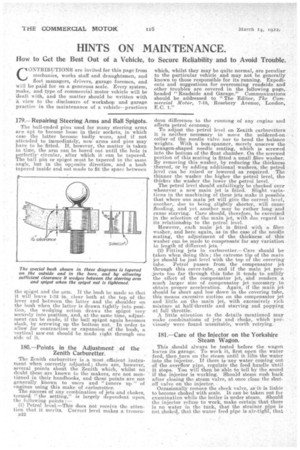179.---Repairing Steering Arms and Bali Spigots.
Page 26

Page 27

If you've noticed an error in this article please click here to report it so we can fix it.
The ball-ended pins used for many steering arms are apt to become loose in their sockets, in which case the latter become badly worn, and if not attended to immediately, new arms and pins may have to be 'fitted. If, however, the matter is taken in time, the arm can be bored out until the hole is perfectly circular, after which it can be tapered. The ball pin or spigot must be tapered to the same angle, but in the opposite direction, and a bush tapered inside and out made to fit the space between the spigot and the arm. If the bush be made so that it will leave 1-32 in. clear both at the top of the lever and between the latter and the shoulder on the bush when the latter is drawn tightly into position, the wedging action draws the spigot very securely into position, and, at the same time, adjustment can be made, if the ball spigot again becomes slack, by screwing up the bottom nut. In order to allow for contraction or expansion of the bush, a vertical saw-cut should be made right through one side of it.
180.—Points in the Adjustment of the Zenith Carburetter.
• The Zenith carburetter is .a most, efficient instrument when correctly adjusted; there are, 'however, several points about the Zenith which, whilst no doubt these -are known to the makers, are not mentioned in their handbooks, and these points are not generally known to users and "timers up " of engines using this make of earburetter_ The success of any combination of jets and chokes, termed the setting," is largely dependent upon_ the following points :— (1) Petrol level.---This does not receive the attention that it merits. Correct level makes a trernene22 dons difference to the running of any engine and affects petrol economy. To adjust the petrol level on Zenith carburetters it is neither necessary to move the soldered-on collar of the needle valve nor to bend the balance weights. With a box-spanner, merely unscrew the hexagon-shaped needle seating, which is screwed into the bottom of the float chamber. On the screwed portion of this seating is fitted a small fibre washer. IV removing this washer, by reducing the thickness thereof, or by adding additional washers, the petrol level can be raised or lowered as required. The 'thinner the washer the higher the petrol level, the thicker -the washer the lower the petrol level. The petrol level should unfailingly be 'checked over whenever a new main jet is fitted. Slight variations in the machining of these jets make it possible. that where one main jet will give the correct level, another, due to being slightly shorter, will cause flooding, and yet• another may be rather long and cause starving. Care should, therefore, be exercised in the selection of the main jet, with due regard to its relationship to the petrol level. However, each main jet is fitted with a fibre washer, and here again, as in the case of the needle seating, the adjustment of the thickness of this washer can be made to compensate for any variation in leng.th of different jets. ' (2) Fitting jets in carburetter,--Care should be taken when doing this ; the extreme tip of the main jet should be just level with the top of the covering tube., Petrol passes from_ the compensator jet through this cover-tube, and if the main jet projects too far through this tube it tends to nullify' the effect of the compensator jet, and renders a much larger size ofcompensator jet necessary to obtain proper acceleration. Again, if the main jet should be short and low down in the covering tube, this means excessive suction on the compensator jet and little on the main jet, with excessively rich mixture at half-throttle and starving and popping at full throttle.'
A little attention to the details mentioned may make combinations of jets and choke, which previously were found unsuitable, worth retrying.
181.—Care of the Injector on the Yorkshire Steam Wagon.
This should always be tested before the wagon leaves its garage. To work it, first open the water feed, then ,turn on the steam until it lifts the water into the injector. If there iseany water c,otning out Of -the overflow pipe, regulate the feed handle until it stops. You will then be able to tell by the sound if the injector is working. Should steam rush back after closing the steam valve, at once close the shutoff valve on the injector..
Occasionally remove the check valve, as it is liable to become choked with scale. It can be taken out for examination while the boiler is under steam. Should the injector refuse to work, make certain that there i3 no water in the tank, that the strainer pipe is not choked, that the water feed pipe is air-tight, that
the union nuts are tight, and that the wing valve of the overflow is not out of order and blowing. , If the injector still refuses to act, take off the caps at the side one at a• time and blow them out by steam, as the cones are liable to become choked with
grit or dirt: Do not enlarge the cone hole hy forcing hard materials through it. The injector will -give little or no trouble if the water tank is washed out frequently, as this will get rid of the dirt before it can cause trouble.,




























